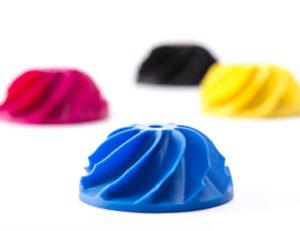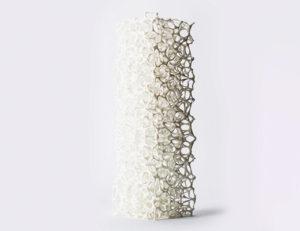 Out of the select few manufacturing enterprises to have received the introductory version of Carbon’s CLIP (Continuous Liquid Interface Production) technology, which has come in the form of their professional-grade 3D printer, the M1, no one has offered us specifics quite like the France-based 3D printing service bureau Sculpteo has. Earlier this year, Carbon announced that they would be partnering with Sculpteo—as well as CIDEAS, The Technology House, and WestStar Precision— effectively integrating their new technology into one of the most successful 3D printing service bureaus in the world.
Out of the select few manufacturing enterprises to have received the introductory version of Carbon’s CLIP (Continuous Liquid Interface Production) technology, which has come in the form of their professional-grade 3D printer, the M1, no one has offered us specifics quite like the France-based 3D printing service bureau Sculpteo has. Earlier this year, Carbon announced that they would be partnering with Sculpteo—as well as CIDEAS, The Technology House, and WestStar Precision— effectively integrating their new technology into one of the most successful 3D printing service bureaus in the world.
Since then, Sculpteo has been experimenting with each of Carbon’s unique resin-based materials, detailing all of their findings in a series of blog posts dedicated to breaking down this new and innovative manufacturing technology. Over the past couple of months, Sculpteo has tested Carbon’s Cyanate Ester and Rigid Polyurethane resins on the M1 printer, showcasing what applications each particular material was best suited for. Now, Sculpteo is focusing on Carbon’s most versatile material yet, their Prototyping Acrylate resin.
 The Prototyping Acrylate resin resembles the material properties of injection molded parts much more closely than other 3D printing techniques, capable of creating smooth objects with a solid infill. The resin is especially ideal for concept prototyping and ornamental objects, and, to a certain extent, can be utilized for more mechanical applications.
The Prototyping Acrylate resin resembles the material properties of injection molded parts much more closely than other 3D printing techniques, capable of creating smooth objects with a solid infill. The resin is especially ideal for concept prototyping and ornamental objects, and, to a certain extent, can be utilized for more mechanical applications.
According to Sculpteo, moving parts can theoretically be 3D printed with Carbon’s Prototyping Acrylate, but that is dependent on your 3D model more than the printing process. The ability to print moving parts is more contingent on the necessitated support and the geometry of the 3D model. Unsure of the clearance required to create these interlocking parts, Sculpteo is currently not offering to 3D print moving parts with any of the available CLIP resins.
 Not only is this material useful in a wide range of general applications, it’s also the only Carbon material that comes in more than one color, and is available in cyan, magenta, yellow, grey, black, and white. Multiple colors can be mixed to create a custom color, but in Sculpteo’s case, this is only available for on-demand bulk orders.
Not only is this material useful in a wide range of general applications, it’s also the only Carbon material that comes in more than one color, and is available in cyan, magenta, yellow, grey, black, and white. Multiple colors can be mixed to create a custom color, but in Sculpteo’s case, this is only available for on-demand bulk orders.
Before the curing process is introduced, the material takes on a shiny appearance, but after curing, the vibrant colors are embedded into a matte surface. By using this resin with the M1, Carbon’s digital light projector (DLP) 3D printer, Sculpteo has been able to achieve extremely high resolution prints, including features that are as thin as 0.25 mm.
All in all, the Prototyping Acrylate allows for extremely fast prototyping with above-average details. As for applicable designs, most average 3D models should be compatible with the M1 and Prototyping Acrylate resin. The one important note for those looking to print with this technology is to ensure that the 3D model doesn’t have an enclosed hollow region, as this will cause the liquid to be trapped within the 3D printed object. To overcome this, 3D designs for the M1 must include an opening to allow drainage of the excess resin from hollow regions.
 When ordering 3D printed parts in Prototyping Acrylate, Sculpteo is able to offer two different types of finishes. Customers can receive their parts raw, which will come with removed supports, or hand polished, which will be manually sanded and polished to remove any support scarring. Using the M1 3D printer, the 3D printing service bureau will continue to experiment with Carbon’s Prototyping Acrylate material, searching for the optimal uses and applications. Although these CLIP resins are still in the testing phase for Sculpteo, customers can register for the CLIP Pilot Program and become one of the first to have their 3D designs created with this lightning-fast, potentially revolutionary 3D printing technology. Discuss further over in the Sculpteo Testing Materials for CLIP M1 3D Printer forum at 3DPB.com.
When ordering 3D printed parts in Prototyping Acrylate, Sculpteo is able to offer two different types of finishes. Customers can receive their parts raw, which will come with removed supports, or hand polished, which will be manually sanded and polished to remove any support scarring. Using the M1 3D printer, the 3D printing service bureau will continue to experiment with Carbon’s Prototyping Acrylate material, searching for the optimal uses and applications. Although these CLIP resins are still in the testing phase for Sculpteo, customers can register for the CLIP Pilot Program and become one of the first to have their 3D designs created with this lightning-fast, potentially revolutionary 3D printing technology. Discuss further over in the Sculpteo Testing Materials for CLIP M1 3D Printer forum at 3DPB.com.
Subscribe to Our Email Newsletter
Stay up-to-date on all the latest news from the 3D printing industry and receive information and offers from third party vendors.
Print Services
Upload your 3D Models and get them printed quickly and efficiently.
You May Also Like
The Dental Additive Manufacturing Market Could Nearly Double by 2033, According to AM Research
According to an AM Research report from 2024, the medical device industry, specifically in dentistry, prosthetics, and audiology, is expected to see significant growth as these segments continue to benefit from...
Heating Up: 3D Systems’ Scott Green Discusses 3D Printing’s Potential in the Data Center Industry
The relentless rise of NVIDIA, the steadily increasing pledges of major private and public investments in national infrastructure projects around the world, and the general cultural obsession with AI have...
AM Research Webinar Explores Continuum’s Sustainable Metal Additive Manufacturing Powders
Metal additive manufacturing (AM) powder supplier Continuum Powders is working to develop solutions that empower industries to reduce waste and optimize their resources. An independent life cycle assessment (LCA) of...
3D Printed Footwear Startup Koobz Lands $7.2M in Seed Round
California-based Koobz is focused on reshoring the U.S. footwear supply chain with advanced manufacturing processes, including 3D printing. The startup just announced that it has added $6 million to its...
































